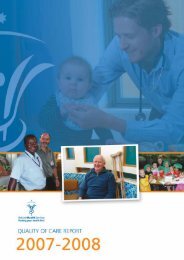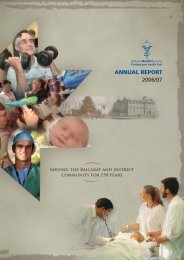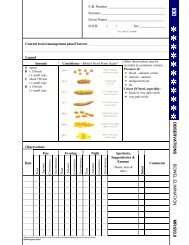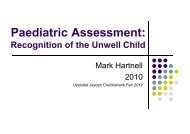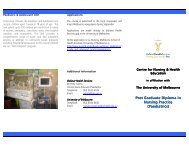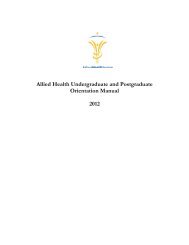2012 Annual Report - Ballarat Health Services
2012 Annual Report - Ballarat Health Services
2012 Annual Report - Ballarat Health Services
Create successful ePaper yourself
Turn your PDF publications into a flip-book with our unique Google optimized e-Paper software.
MENTAL HEALTH<br />
SERVICES<br />
Mental <strong>Health</strong> <strong>Services</strong> were signifi cantly restructured over the<br />
course of the year. This has resulted in the employment of more<br />
mental health professionals and the establishment of mental<br />
health teams better able to meet the community’s mental health<br />
needs.<br />
The teams include:<br />
The Infant and Child Mental <strong>Health</strong> Team which supports<br />
children aged up to 14 years;<br />
The Youth Mental <strong>Health</strong> Team which supports those aged 15<br />
to 25 years;<br />
The Adult Mental <strong>Health</strong> Team for the 26 to 64 age group;<br />
and,<br />
The Seniors Mental <strong>Health</strong> Team for those aged over 65 years.<br />
The restructure, which saw a 28 per cent increase in the number<br />
of young people accepted for mental health treatment, has been<br />
part of a demonstration project funded by the State Government<br />
and provides a template for mental health services elsewhere in<br />
the state.<br />
The demonstration project provides a greater emphasis on<br />
early intervention with the Infant and Child Team operating an<br />
expanded CAST (Cool at School Together) program in partnership<br />
with the Department of Education and Early Childhood<br />
Development and Catholic Education Offi ce that is now offered<br />
to kindergartens.<br />
Feedback from young people, carers and other primary care<br />
providers is that the service is now far more responsive and<br />
accessible.<br />
RESIDENTIAL CARE<br />
The process of consolidating our residential facilities in Sebastopol<br />
began with the merger of Jessie Gillett with the refurbished<br />
James Thomas Court Hostel.<br />
This was in response to an ongoing decline in demand for<br />
low-care residential accommodation. Jessie Gillett, which could<br />
potentially accommodate more than 40 residents, had been home<br />
to just 15 residents leading up to the merger.<br />
Most residents chose to move into the James Thomas Court<br />
Hostel, which is directly connected to the Jessie Gillett Hostel.<br />
Jessie Gillett staff were redeployed to other BHS residential<br />
services.<br />
Under the recently appointed Executive Director of Residential<br />
<strong>Services</strong>, Sue Gervasoni, many new and contemporary approaches<br />
to residential care are evident, including the introduction of the<br />
Respecting Patient Choices Program.<br />
Congratulations are also extended to all staff in Residential<br />
<strong>Services</strong> for the achievement of full accreditation status in the<br />
recent survey process.<br />
WOUND CARE PROJECT<br />
Pressure ulcers or “bed sores” were reduced to an alltime<br />
low at BHS this year as a result of a fresh approach<br />
to wound care. The number of acute care patients with<br />
pressure wounds at the <strong>Ballarat</strong> Base Hospital dropped to<br />
just three per cent by June <strong>2012</strong>, down from 11 per cent<br />
in early 2010.<br />
These fi gures represent one of the lowest international<br />
pressure ulcer rates and are believed to set a new<br />
benchmark for Australian hospitals As a consequence<br />
the BHS Wound Care Improvement Program, introduced<br />
in 2010 with partner Smith and Nephew, is being<br />
introduced by a number of other Victorian health<br />
services.<br />
BHS adopted new, evidence-based education modules<br />
on how to better care for patients who entered hospital<br />
with an existing pressure ulcer, or who were at risk of<br />
developing a pressure ulcer while in hospital.<br />
The other signifi cant change involved a streamlining of<br />
the range of wound dressings used within the health<br />
service from 130 different products to about 20. This has<br />
made the management of dressings much simpler and<br />
more effective.<br />
The new program also generated savings in the cost of<br />
wound care products. Part of these savings has been<br />
invested in the employment of additional wound care<br />
consultants.<br />
www.bhs.org.au 7




